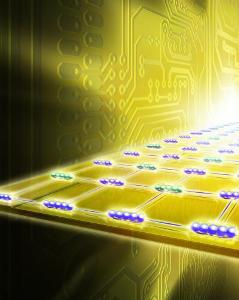Feb 25 2011
The Austrian research group led by physicist Rainer Blatt suggests a fundamentally novel architecture for quantum computation.
They have experimentally demonstrated quantum antennae, which enable the exchange of quantum information between two separate memory cells located on a computer chip. This offers new opportunities to build practical quantum computers. The researchers have published their work in the scientific journal Nature.
 Quantum antennae enable the exchange of quantum information between two separate memory cells located on a computer chip.
Quantum antennae enable the exchange of quantum information between two separate memory cells located on a computer chip.
Six years ago scientists at the University of Innsbruck realized the first quantum byte – a quantum computer with eight entangled quantum particles; a record that still stands. "Nevertheless, to make practical use of a quantum computer that performs calculations, we need a lot more quantum bits," says Prof. Rainer Blatt, who, with his research team at the Institute for Experimental Physics, created the first quantum byte in an electromagnetic ion trap. "In these traps we cannot string together large numbers of ions and control them simultaneously." To solve this problem, the scientists have started to design a quantum computer based on a system of many small registers, which have to be linked. To achieve this, Innsbruck quantum physicists have now developed a revolutionary approach based on a concept formulated by theoretical physicists Ignacio Cirac and Peter Zoller. In their experiment, the physicists electromagnetically coupled two groups of ions over a distance of about 50 micrometers. Here, the motion of the particles serves as an antenna. "The particles oscillate like electrons in the poles of a TV antenna and thereby generate an electromagnetic field," explains Blatt. "If one antenna is tuned to the other one, the receiving end picks up the signal of the sender, which results in coupling." The energy exchange taking place in this process could be the basis for fundamental computing operations of a quantum computer.
Antennae amplify transmission
"We implemented this new concept in a very simple way," explains Rainer Blatt. In a miniaturized ion trap a double-well potential was created, trapping the calcium ions. The two wells were separated by 54 micrometers. "By applying a voltage to the electrodes of the ion trap, we were able to match the oscillation frequencies of the ions," says Blatt. "This resulted in a coupling process and an energy exchange, which can be used to transmit quantum information." A direct coupling of two mechanical oscillations at the quantum level has never been demonstrated before. In addition, the scientists show that the coupling is amplified by using more ions in each well. "These additional ions function as antennae and increase the distance and speed of the transmission," says Rainer Blatt, who is excited about the new concept. This work constitutes a promising approach for building a fully functioning quantum computer. "The new technology offers the possibility to distribute entanglement. At the same time, we are able to target each memory cell individually," explains Rainer Blatt. The new quantum computer could be based on a chip with many micro traps, where ions communicate with each other through electromagnetic coupling. This new approach represents an important step towards practical quantum technologies for information processing.
Source: http://www.uibk.ac.at/